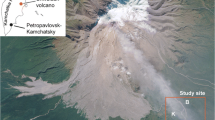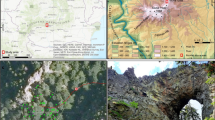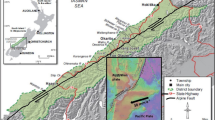Abstract
Lahars on volcanic terrain are recurrent phenomena with a high capacity to transform landscape and cause significant economic and life losses. Lahars have been studied in most volcanic regions, mostly based on the recognition of cotemporaneous events. Yet, there is a lack of long-term record about their frequency and magnitude. Such long-term records could help to improve lahar risk assessment and understand climate triggering factors. Here, we aim at providing the longest annual resolved frequency-magnitude lahar records of the Trans-Mexican Volcanic Belt. We focus on the Jamapa Gorge of the Pico de Orizaba volcano and apply geomorphological and dendrogeomorphological methodological approaches. Besides, we used a 2D numerical model to estimate the discharge of the reconstructed lahars based on the paleostage indicators (PSIs) defined by scars on trees. A total of 78 Pinus hartwegii trees were sampled for the reconstruction of lahars. We identified 157 growth disturbances related to past lahar activity, namely scars (51%), growth suppression (35%), and compression wood (32%). A total of 8 lahars were reconstructed between 1930 and 2017 (1931, 1960, 1968, 1975, 1999, 2012, 2014, and 2016) with a reconstructed peak discharge ranging between 80 and 350 m3/s. Largest events occurred in 1975 and 2012 with lahar discharges of 160 m3/s and 91 m3/s, respectively. Lahar events were linked to intense rainfall events and the passage of hurricanes and tropical storms coming from the Atlantic Ocean. These results highlight the benefit of the combined use of dendrogeomorphology and numerical modeling to gather longer series of lahar activity in volcanoes, where such information is largely lacking. The methodological approach deployed here can be applied consistently and uniformly in other volcanic regions to characterize lahar hazard, regardless of physiographic and climatic contexts.








Similar content being viewed by others
Data availability
The datasets generated during the current study are available from the corresponding author on reasonable request.
References
Baker VR (2008) Paleoflood hydrology: origin, progress, prospects. Geomorphology 101:1–13. https://doi.org/10.1016/j.geomorph.2008.05.016
Ballesteros Cánovas JA, Eguibar M, Bodoque JM, Díez-Herrero A, Stoffel M, Gutiérrez-Pérez I (2011) Estimating flash flood discharge in an ungauged mountain catchment with 2D hydraulic models and dendrogeomorphic palaeostage indicators. Hydrol Process 25:970–979. https://doi.org/10.1002/hyp.7888
Ballesteros JA, Bodoque JM, Díez-Herrero A, Sanchez-Silva M, Stoffel M (2011) Calibration of floodplain roughness and estimation of flood discharge based on tree-ring evidence and hydraulic modelling. J Hydrol 403:103–115. https://doi.org/10.1016/j.jhydrol.2011.03.045
Ballesteros-Cánovas JA, Stoffel M, Spyt B, Janecka K, Kaczka RJ, Lempa M (2016) Paleoflood discharge reconstruction in Tatra Mountain streams. Geomorphology 272:92–101. https://doi.org/10.1016/j.geomorph.2015.12.004
Benito G, Thorndycraft VR (2005) Palaeoflood hydrology and its role in applied hydrological sciences. J Hydrol 313:3–15. https://doi.org/10.1016/j.jhydrol.2005.02.002
Bodoque JM, Díez-Herrero A, Eguibar MA, Benito G, Ruiz-Villanueva V, Ballesteros-Cánovas JA (2015) Challenges in paleoflood hydrology applied to risk analysis in mountainous watersheds - a review. J Hydrol 529:449–467. https://doi.org/10.1016/j.jhydrol.2014.12.004
Bollschweiler M, Stoffel M, Vázquez-Selem L, Palacios D (2010) Tree-ring reconstruction of past lahar activity at Popocatépetl volcano, Mexico. Holocene 20:265–274. https://doi.org/10.1177/0959683609350394
Bono L, Amigo Á (2015) Modelamiento de los lahares ocurridos en el volcán Calbuco 2015 con el software RAMMS. XIV Congr Geológico Chil:162–165
Bühler Y, Christen M, Kowalski J, Bartelt P (2011) Sensitivity of snow avalanche simulations to digital elevation model quality and resolution. Ann Glaciol 52:72–80. https://doi.org/10.3189/172756411797252121
Caballero L, Capra L (2014) The use of FLO2D numerical code in lahar hazard evaluation at Popocatépetl volcano: A 2001 lahar scenario. Nat Hazards Earth Syst Sci 14:3345–3355. https://doi.org/10.5194/nhess-14-3345-2014
Caballero L, Capra L, Vázquez R, Riley K, Webley P, Thompson M (2016) Evaluating the performance of FLO2D for simulating past lahar events at the most active Mexican volcanoes: Popocatépetl and Volcán de Colima. Natural Hazard Uncertainty Assessment: Modeling and Decision Support; Geophys Monograph: Washington, DC, USA, 223:179-189
Cannon SH, Reneau SL (2000) Conditions for generation of fire-related debris flows, Capulin Canyon, New Mexico. Earth Surf Process Landf 25:1103–1121
Capra L, Borselli L, Varley N, Gavilanes-Ruiz JC, Norini G, Sarocchi D, Caballero L, Cortes A (2010) Rainfall-triggered lahars at Volcán de Colima, Mexico: Surface hydro-repellency as initiation process. J Volcanol Geotherm Res 189:105–117. https://doi.org/10.1016/j.jvolgeores.2009.10.014
Capra L, Coviello V, Borselli L, Márquez-Ramírez VH, Arámbula-Mendoza R (2018) Hydrological control of large hurricane-induced lahars: evidence from rainfall-runoff modeling, seismic and video monitoring. Nat Hazards Earth Syst Sci 18:781–794. https://doi.org/10.5194/nhess-18-781-2018
Carrasco-Núñez G (2000) Structure and proximal stratigraphy of Citlaltépetl volcano (Pico de Orizaba), Mexico. Spec Pap Geol Soc Am 334:247–262. https://doi.org/10.1130/0-8137-2334-5.247
Carrasco-Núñez G, Díaz-Castellón R, Siebert L, Hubbard B, Sheridan MF, Rodríguez SR (2006) Multiple edifice-collapse events in the Eastern Mexican Volcanic Belt: the role of sloping substrate and implications for hazard assessment. J Volcanol Geotherm Res 158:151–176. https://doi.org/10.1016/j.jvolgeores.2006.04.025
Charbonnier SJ, Gertisser R (2012) Evaluation of geophysical mass flow models using the 2006 block-and-ash flows of Merapi Volcano, Java, Indonesia: towards a short-term hazard assessment tool. J Volcanol Geotherm Res 231–232:87–108. https://doi.org/10.1016/j.jvolgeores.2012.02.015
Chiarle M, Iannotti S, Mortara G, Deline P (2007) Recent debris flow occurrences associated with glaciers in the Alps. Glob Planet Chang 56:123–136. https://doi.org/10.1016/j.gloplacha.2006.07.003
Chmutina K, Von Meding J, Bosher L (2019) Language matters: dangers of the “natural disaster” misnomer. Glob Aasessment Rep disaster risk Reduct 2019:1–22
Christen M, Bühler Y, Bartelt P, et al (2012) Integral hazard management using a unified software environment. In: 12th Congress Interpraevent (pp. 77–86)
Comisión Nacional del Agua (CONAGUA) (2014) Caracterización fluvial e hidráulica de las inundaciones en México.
Davila N, Capra L, Gavilanes-Ruiz JC, Varley N, Norini G, Vazquez AG (2007) Recent lahars at Volcán de Colima (Mexico): drainage variation and spectral classification. J Volcanol Geotherm Res 165:127–141. https://doi.org/10.1016/j.jvolgeores.2007.05.016
Díaz V, Paredes C, García C et al (2010) Árboles Longevos De México. Rev Mex Ciencias For 1:7–29
Díez-Herrero A, Ballesteros-Cánovas JA, Bodoque JM, Ruiz-Villanueva V (2013a) A new methodological protocol for the use of dendrogeomorphological data in flood risk analysis. Hydrol Res 44:234–247. https://doi.org/10.2166/nh.2012.154
Díez-Herrero A, Ballesteros JA, Ruiz-Villanueva V, Bodoque JM (2013b) A review of dendrogeomorphological research applied to flood risk analysis in Spain. Geomorphology 196:211–220. https://doi.org/10.1016/j.geomorph.2012.11.028
ESRI (2016) ArcGIS Desktop: Release 10.5.
Fernández de Castro Martínez G, Vázquez Selem L, Palacio Prieto JL, et al (2018) Geomorfometría y cálculo de erosión hídrica en diferentes litologías a través de fotogrametría digital con drones. Investig Geográficas https://doi.org/10.14350/rig.59548
Fischer J-T, Kowalski J, Pudasaini SP (2012) Topographic curvature effects in applied avalanche modeling. Cold Reg Sci Technol 74–75:21–30. https://doi.org/10.1016/j.coldregions.2012.01.005
Franco-Ramos O, Stoffel M, Vázquez-Selem L, Capra L (2013) Spatio-temporal reconstruction of lahars on the southern slopes of Colima volcano, Mexico – a dendrogeomorphic approach. J Volcanol Geotherm Res 267:30–38. https://doi.org/10.1016/j.jvolgeores.2013.09.011
Franco-Ramos O, Castillo M, Muñoz-Salinas E (2016a) Using tree-ring analysis to evaluate intra-eruptive lahar activity in the Nexpayantla Gorge, Popocatépetl volcano (central Mexico). Catena 147:205–215. https://doi.org/10.1016/j.catena.2016.06.045
Franco-Ramos O, Stoffel M, Vázquez-Selem L (2016b) Tree-ring based record of intra-eruptive lahar activity: Axaltzintle valley, Malinche volcano, Mexico. Geochronometria 43:74–83. https://doi.org/10.1515/geochr-2015-0033
Franco-Ramos O, Stoffel M, Vázquez-Selem L (2017) Tree-ring based reconstruction of rockfalls at Cofre de Perote volcano, Mexico. Geomorphology 290:142–152. https://doi.org/10.1016/j.geomorph.2017.04.003
Franco-Ramos O, Stoffel M, Ballesteros-Cánovas JA (2019) Reconstruction of debris-flow activity in a temperate mountain forest catchment of central Mexico. J Mt Sci 16:2096–2109. https://doi.org/10.1007/s11629-019-5496-6
Franco-Ramos O, Ballesteros-Cánovas JA, Figueroa-García JE, Vázquez-Selem L, Stoffel M, Caballero L (2020) Modelling the 2012 lahar in a sector of Jamapa Gorge (Pico de Orizaba Volcano, Mexico) using RAMMS and tree-ring evidence. Water 12:333. https://doi.org/10.3390/w12020333
Garrote J, Díez-Herrero A, Génova M et al (2018) Improving flood maps in ungauged fluvial basins with dendrogeomorphological data. An Example from the Caldera de Taburiente National Park (Canary Islands, Spain). Geosciences 8:300. https://doi.org/10.3390/geosciences8080300
Haddad B, Palacios D, Pastor M, Zamorano JJ (2016) Smoothed particle hydrodynamic modeling of volcanic debris flows: application to Huiloac Gorge lahars (Popocatépetl volcano, Mexico). J Volcanol Geotherm Res 324:73–87. https://doi.org/10.1016/j.jvolgeores.2016.05.016
Holmes RL (1983) Computer-assisted quality control in tree-ring dating and measurement. Tree-Ring Bull 43:69–78
Hoskuldsson A, Robin C (1993) Late Pleistocene to Holocene eruptive activity of Pico de Orizaba, Eastern Mexico. Bull Volcanol 55:571–587. https://doi.org/10.1007/BF00301810
Iverson RM, Schilling SP, Vallance JW (1998) Objective delineation of lahar-inundation hazard zones. Geol Soc Am Bull 110:972–984
Lugo-Hubp J (1988) Elementos de geomorfología aplicada, 1era Edici. Universidad Nacional Autónoma de México, Mexico
Luna Q (2007) Assessment and modelling of two lahars caused by "Hurricane Stan" at Atitlan, Guatemala, October 2005 (Master's thesis)
Morales Martínez MA, Welsh Rodríguez CM, Ruelas Monjardín LC et al (2016) Afectaciones por posible asociación de eventos hidrometeorológicos y geológicos en los municipios de Calcahualco y Coscomatepec, Veracruz. Teoría y Prax 12:31–49. https://doi.org/10.22403/UQROOMX/TYPNE2016/02
Muñoz-Salinas E, Castillo-Rodríguez M, Manea V, Manea M, Palacios D (2009) Lahar flow simulations using LAHARZ program: Application for the Popocatépetl volcano, Mexico. J Volcanol Geotherm Res 182:13–22. https://doi.org/10.1016/j.jvolgeores.2009.01.030
National Oceanic and Atmospheric Administration (NOAA) (2019) Historical Hurricanes Tracks. https://coast.noaa.gov/hurricanes/. Accessed 1 Dec 2019
Nocentini M, Tofani V, Gigli G, Fidolini F, Casagli N (2015) Modeling debris flows in volcanic terrains for hazard mapping: the case study of Ischia Island (Italy). Landslides 12:831–846. https://doi.org/10.1007/s10346-014-0524-7
O’Brien JS, Julien PY, Fullerton WT (1993) Two-dimensional water flood and mudflow simulation. J Hydraul Eng 119:244–261. https://doi.org/10.1061/(ASCE)0733-9429(1993)119:2(244)
Pierson TC, Major JJ (2014) Hydrogeomorphic effects of explosive volcanic eruptions on drainage basins. Annu Rev Earth Planet Sci 42:469–507. https://doi.org/10.1146/annurev-earth-060313-054913
Pierson TC, Pringle PT, Cameron KA (2011) Magnitude and timing of downstream channel aggradation and degradation in response to a dome-building eruption at Mount Hood, Oregon. Bull Geol Soc Am 123:3–20. https://doi.org/10.1130/B30127.1
Pierson TC, Wood NJ, Driedger CL (2014) Reducing risk from lahar hazards: concepts, case studies, and roles for scientists. J Appl Volcanol 3:1–25. https://doi.org/10.1186/s13617-014-0016-4
Prado-Lallande A (2017) Geomorfología, dendrocronología y análisis sedimentológico en la cuenca alta del valle Alcalican, SW del volcán Iztaccíhuatl. Tesis de Licenciatura, Universidad Nacional Autónoma de México
Quesada-Román A, Ballesteros-Cánovas JA, Granados-Bolaños S, Birkel C, Stoffel M (2020) Dendrogeomorphic reconstruction of floods in a dynamic tropical river. Geomorphology 359:107133. https://doi.org/10.1016/j.geomorph.2020.107133
Rinn F (2003) TSAP-Win. Time series analysis and presentation for dendrochronology and 409 related applications. 22
Robinson WJ, Evans R (1980) A microcomputer-based tree-ring measuring system. Tree-Ring Bull 40:59–64
Rodríguez SR, Mora-González I, Murrieta-Hernández JL (2006) Flujos de baja concentración asociados con lluvias de intensidad extraordinaria en el flanco sur del volcán Pico de Orizaba (Citlaltépetl), México. Bol Soc Geol Mex 58:223–236. https://doi.org/10.18268/bsgm2006v58n2a5
Salaorni E, Stoffel M, Tutubalina O, Chernomorets S, Seynova I, Sorg A (2017) Dendrogeomorphic reconstruction of lahar activity and triggers: Shiveluch volcano, Kamchatka Peninsula, Russia. Bull Volcanol 79. https://doi.org/10.1007/s00445-016-1094-4
Schilling S (2014) Laharz_py: GIS tools for automated mapping of lahar inundation hazard zones. US Department of the Interior, Geological Survey
Servicio Meteorológico Nacional (SMN) (2008) https://smn.cna.gob.mx. Accessed 28 Nov 2019
Servicio Meteorológico Nacional (SMN) (2012) https://smn.cna.gob.mx. Accessed 28 Nov 2019
Servicio Meteorológico Nacional (SMN) (2016) https://smn.cna.gob.mx. Accessed 28 Nov 2019
Siebe C, Abrams M, Sheridan MF (1993) Major Holocene block-and-ash fan at the western slope of ice-capped Pico de Orizaba volcano, México: implications for future hazards. J Volcanol Geotherm Res 59:1–33. https://doi.org/10.1016/0377-0273(93)90075-3
Smith GA, Fritz WJ (1989) Volcanic influences on terrestrial sedimentation. Geology 17:375
Staley DM, Kean JW, Cannon SH, Schmidt KM, Laber JL (2013) Objective definition of rainfall intensity-duration thresholds for the initiation of post-fire debris flows in southern California. Landslides 10:547–562. https://doi.org/10.1007/s10346-012-0341-9
Stevens N, Manville V, Heron D (2003) The sensitivity of a volcanic flow model to digital elevation model accuracy: experiments with digitised map contours and interferometric SAR at Ruapehu and Taranaki volcanoes, New Zealand. J Volcanol Geotherm Res 119:89–105. https://doi.org/10.1016/S0377-0273(02)00307-4
Stoffel M, Corona C (2014) Dendroecological dating of geomorphic disturbance in trees. Tree-Ring Res 70:3–20. https://doi.org/10.3959/1536-1098-70.1.3
Stoffel M, Bollschweiler M, Vázquez-Selem L, Franco-Ramos O, Palacios D (2011) Dendrogeomorphic dating of rockfalls on low-latitude, high-elevation slopes: Rodadero, Iztaccíhuatl volcano, Mexico. Earth Surf Process Landf 36:1209–1217. https://doi.org/10.1002/esp.2146
Stokes MA, Smiley TL (1968) An introduction to tree–ring dating. University of Chicago Press, Chicago, IL
Thouret JC, Antoine S, Magill C, Ollier C (2020) Lahars and debris flows: characteristics and impacts. Earth-Science Rev 201:103003. https://doi.org/10.1016/j.earscirev.2019.103003
Tichavský R, Koutroulis A, Chalupová O, Chalupa V, Šilhán K (2020) Flash flood reconstruction in the Eastern Mediterranean: regional tree ring-based chronology and assessment of climate triggers on the island of Crete. J Arid Environ 177:104135. https://doi.org/10.1016/j.jaridenv.2020.104135
UN (2015) Sendai Framework for Disaster Risk Reduction 2015–2030. http://www.unisdr.org/files/43291_sendaiframeworkfordrren.pdf. Accessed 18 Jan 2021
Vargas G, Rutllant J, Ortlieb L (2006) ENSO tropical–extratropical climate teleconnections and mechanisms for Holocene debris flows along the hyperarid coast of western South America (17°–24°S). Earth Planet Sci Lett 249:467–483. https://doi.org/10.1016/j.epsl.2006.07.022
Vàzquez R, Capra L, Caballero L et al (2014) The anatomy of a lahar: deciphering the 15th September 2012 lahar at Volcán de Colima, Mexico. J Volcanol Geotherm Res 272:126–136. https://doi.org/10.1016/j.jvolgeores.2013.11.013
Voellmy A (1955) Über die Zerstörungskraft von Lawinen. Schweiz Bauztg 73:159–162
Wilhelm B, Ballesteros Cánovas JA, Macdonald N, Toonen WHJ, Baker V, Barriendos M, Benito G, Brauer A, Corella JP, Denniston R, Glaser R, Ionita M, Kahle M, Liu T, Luetscher M, Macklin M, Mudelsee M, Munoz S, Schulte L, St. George S, Stoffel M, Wetter O (2019) Interpreting historical, botanical, and geological evidence to aid preparations for future floods. Wiley Interdiscip Rev Water 6:e1318. https://doi.org/10.1002/wat2.1318
Williams R, Stinton AJ, Sheridan MF (2008) Evaluation of the Titan2D two-phase flow model using an actual event: case study of the 2005 Vazcún Valley Lahar. J Volcanol Geotherm Res 177:760–766. https://doi.org/10.1016/j.jvolgeores.2008.01.045
Worni R, Huggel C, Stoffel M, Pulgarín B (2012) Challenges of modeling current very large lahars at Nevado del Huila Volcano, Colombia. Bull Volcanol 74:309–324. https://doi.org/10.1007/s00445-011-0522-8
Acknowledgements
We acknowledge Andrés Prado, Salvador Ponce, Mireya Vazquez, and Alejandra Franco for their support during fieldwork.
Code availability
Not applicable.
Funding
This work was funded by UNAM DGAPA-PAPIIT project IA100619.
Author information
Authors and Affiliations
Contributions
Not applicable.
Corresponding author
Ethics declarations
Competing interests
The authors declare no competing interests.
Rights and permissions
About this article
Cite this article
Figueroa-García, J.E., Franco-Ramos, O., Bodoque, J.M. et al. Long-term lahar reconstruction in Jamapa Gorge, Pico de Orizaba (Mexico) based on botanical evidence and numerical modelling. Landslides 18, 3381–3392 (2021). https://doi.org/10.1007/s10346-021-01716-3
Received:
Accepted:
Published:
Issue Date:
DOI: https://doi.org/10.1007/s10346-021-01716-3




